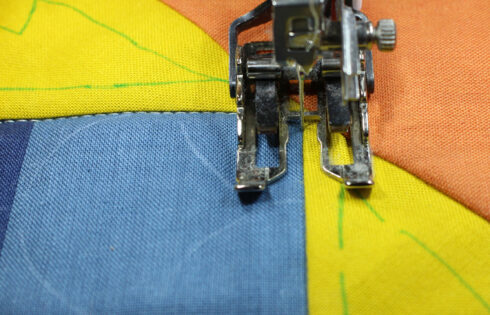Question:
I just finished this durable tote bag and am delighted with the way it turned out. I chose heavy cotton ticking for the main part of the bag, and a bright fruit patterned cotton fabric for the pocket panels (I lined the pockets with the ticking fabric.) The bag lining is the heaviest muslin I had in my stash. It was fairly simple to make until I got to sewing on the straps. In the beginning I would never have guessed the straps would give me such trouble, but every time I had them pinned on and started sewing them, the fabric underneath would buckle just enough to create pleats in the pockets. I had to rip out again and again. I finally succeeded in getting them on reasonably smooth, but it stressed me out for a while. Is there any trick to this procedure? The tote, in spite of all that, turned out to be really lovely.
Answer:
We admire your perseverance and that you took the time to remove the stitching and start over until you were satisfied with the results. The weight of the straps may have played a part in why you experienced this problem but the same problem has been known to happen when you are joining two pieces of identical fabric that line up perfectly, yet one is stretched out when you reach the end of a seam. It would be easy if I could say change “X” and the problem would be solved but as with many things, there is more than one solution. Let’s explore some solutions to the problem she experienced.

Possible Solutions:
The heavier strap material is preventing both layers of fabric from feeding evenly under the presser foot. Adjusting the pressure on the presser foot can help eliminate this problem. This is achieved through an adjustment on your sewing machine. Having too much pressure on the foot or not enough pressure can both play a part in how the layers are not feeding evenly. Another solution, without making adjustments to your sewing machine, is to place paper under the fabric. The paper will stop the feed dog from grabbing the fabric and will rip out when you are done sewing.
The type of presser foot on your sewing machine can make a difference in the way the fabric is fed through the sewing machine. An even feed or walking presser foot can change the drag the foot has on the upper layer of fabric. A Teflon presser foot can also help with some fabrics. Many quilters won’t even try piecing without their walking or even feed foot so you may find this foot in the accessories at a quilt shop. A local sewing machine dealer can guide you to a presser foot that will help solve your problem. Bring the make and model of your sewing machine with you so the dealer can match the correct shank size and be of the most assistance.
Remember that how you hold the fabric can also make a difference. It is possible to inadvertently stretch one layer of the fabric if you are tensely holding on the fabric. You must let the feed dogs on your sewing machine do the work.
Hand basting the layers together is a solution that requires a little bit of time but it can be the best solution to hold everything where you need it until the final stitching is in place.
A temporary spray adhesive, available in almost all fabric stores, is another solution. In this particular case, applying the temporary spray adhesive to the back of the strap and putting it in place can help, but it still may not be enough to held it in place if the amount of pressure on the presser foot is not correctly set. What ever you do, don’t give up. Perseverance will always win so you can be proud of what you created.